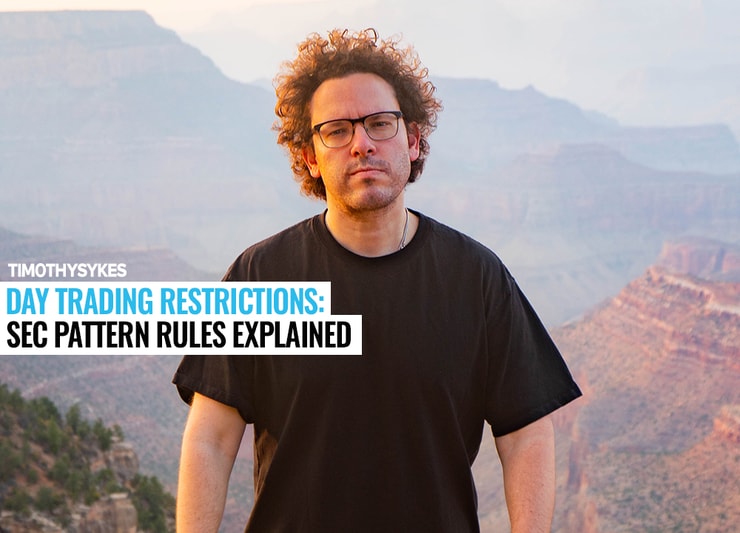I used to be one of those traders who complained about day trading restrictions.
But here’s the thing … I trade some of the sketchiest stocks in the world. So I’ve had to learn in 20+ years of trading that I have to protect myself from big losses.
Trading penny stocks can be risky.
That’s one reason the Securities and Exchange Commission (SEC) has day trading restrictions — to protect newbies from overtrading and blowing up their accounts.
When I first started trading, I didn’t understand how helpful these restrictions can be for new traders. I wanted to be able to trade any stock, any time, without the SEC interfering.

Now I understand how day trading restrictions can help protect newbies.
I’ve been able to make millions from day trading, but it hasn’t been easy.* Most traders lose. The rules I’ve learned help me stay safe while I trade sketchy penny stocks. And they’re the same rules I teach to my students now. I have multiple millionaire students.*
Apply to see if you’re ready for the Trading Challenge, where all my millionaire students started. I think it’s the best trading community you’ll ever find.
The path to successful day trading is tough. How can day trading restrictions keep you safe?
Read on to learn more.
Table of Contents
- 1 What Is a Day Trade?
- 2 Why Does Day Trading Have Restrictions?
- 3 SEC Pattern Rules Explained
- 4 Day Trading Restrictions in the U.S.
- 5 Day Trading Restrictions in Canada
- 6 Day Trading Restrictions in the U.K.
- 7 How Can I Get Around the Day Trade Limit?
- 7.1 Tips for Day Trading Restrictions #1: Day Trade in Foreign Stock Markets
- 7.2 Tips for Day Trading Restrictions #2: Open Multiple Day Trading Accounts
- 7.3 Tips for Day Trading Restrictions #3: Open a Cash Account
- 7.4 Tips for Day Trading Restrictions #4: Overnight Holds
- 7.5 Tips for Day Trading Restrictions #5: Join a Day Trader Firm
- 8 What Happens if I Day Trade While Restricted?
- 9 Frequently Asked Questions About Day Trading Restrictions
- 10 Day Trading Restrictions: The Bottom Line
What Is a Day Trade?
A day trade is when you open and close a position on the same trading day. The term applies to long and short positions and all securities.
The number of day trades can be confusing when entering and exiting a position many times.
Say you enter two orders to buy a stock. You then sell your shares the same day but as one order. That counts as one trade.
The opposite situation ends with the same result.
If you were to enter a position with two separate orders and exit the position that same day with two separate orders, that counts as two trades.
And if your broker fills part of your order right away and the rest later, that doesn’t count as multiple orders. That’s as long as you don’t modify the initial order after you submit it. Changing an order can increase the number of day trades.
Some day trading restrictions aim to limit the number of day trades a trader can make unless they have sufficient funds in their account.
These rules are to help protect both traders and brokers.
Why Does Day Trading Have Restrictions?

Day trading restrictions exist to keep inexperienced traders safe. That’s the line from the government, anyway.
But it’s smart to pay attention to the regulation. Some of the most popular stocks for day traders — penny stocks — are also the most dangerous. Volatility and low liquidity make for a dangerous trading environment.
It’s possible to profit if you know what you’re doing. I now have several millionaire students who took years to learn how to trade safely.*
You can learn too. For starters, you can check out my no-cost “Volatility Survival Guide” to learn how to navigate volatility.
Restrictions aren’t designed just to help new traders. They also aim to protect brokers. Remember, most traders lose. So no big surprise that brokers feel like they need some protection from careless traders.
SEC Pattern Rules Explained
FINRA (Financial Industry Regulatory Authority) created the pattern day trader (PDT) rule in 2001. Traders who meet the criteria for a pattern day trader are subject to the rule, which the SEC enforces.
According to the SEC, a pattern day trader is anyone who makes more than four day trades in a rolling five-day period.
Traders with margin accounts need a minimum balance of $25,000 to engage in pattern day trading. Any margin account flagged as a pattern day trader can’t trade with a balance below that. But not all accounts are subject to the PDT rule…
The rule doesn’t apply to cash accounts or accounts where day trading is less than 6% of the total trading activity.
You can also be flagged as a day trader if your broker has reason to suspect you’ll engage in day trading activities. Say you took a day trading course with your broker before beginning to trade, for example.
If your account falls below the $25,000 minimum by the end of the trading day, you’ll be restricted until you deposit funds to get back to the minimum.
The account minimum can be cash and/or eligible securities. So if you have long positions, keep an eye on how they affect your account balance.
Day trading accounts can’t be cross-guaranteed. You must meet the minimum account balance with cash and securities in that specific account.
SEC Day Trade Buying Power
Margin trading can sound great … until you dig a little deeper.
On the surface, as long as you have the minimum account balance, you can day trade with four times the margin excess at the close of the previous trading day.
Let me say that more plainly … You can borrow four times the amount over the minimum balance requirement you have in your margin account.
So for example … An account with $35,000 has potential buying power of $75,000. That’s because the account is $10,000 over the minimum balance requirement, and 4 x $10,000 = $40,000. And $40,000 + $35,000 = $75,000.
If a trader exceeds the buying power limitation, the broker issues a margin call. That trader then has five days to answer it. Until then, margin trading may be restricted to twice the margin excess.
If after five days the trader doesn’t meet the margin call, their account may be restricted to cash-only trading for 90 days or until they meet the margin call.
Let me be clear: Trading on margin is risky. I get the temptation. Trading with more money can mean higher profits. But it also means a possibility of bigger losses.
Never trade with more than you can afford to lose. And if you’re borrowing money to trade with, you probably couldn’t afford to lose it…
You must manage your risk. Without discipline and experience, losses can pile up.
That’s why my rule #1 is to always cut losses quickly. Losses are inevitable, but managing risk can help traders get out safely when trades go south. All my top students will tell you that risk management is crucial.
Unfamiliar with some of these terms? Check out this quick guide.
Day Trading Restrictions in the U.S.
U.S. traders have to follow the SEC’s day trading restrictions. Individual brokers like E-Trade, Robinhood, and Webull may have more strict day trading regulations.
So depending on the broker and the securities, the definition of a pattern day trader may vary. Some brokers may only require three day trades instead of four to flag an account.
What’s the right broker for you? Do your research and choose the best option for your account size and strategy. Here’s one place to start.
Minimum Requirements
There may be penalties for accounts that slip below minimums. The SEC’s minimum is $25,000 for the PDT rule, but some brokers may ask for more. It depends on what you trade and the level of risk your account poses to a broker.
Day traders who meet account minimums are granted buying power four times that of their margin excess. For some brokers — and depending on what you trading — the buying power is less.
This applies strictly to day trades with a margin account.
Say a day trader attempts to hold a margin position overnight above the normal margin account borrowing power. (That’s twice the margin excess.) The broker could liquidate the trader’s position liquidation…
And it’s all at the broker’s discretion. Why would a broker do that? To bring the trader and the account in line with margin rules.
Taxes
Taxes are complex. So in no way should you consider this the final word. Always consult a licensed tax professional. That said, at writing, in the U.S. day trading profits are taxed at the normal income rate. How much you pay in taxes depends on how much you make day trading.
Get a brief run-down on day trading taxes here.
Day Trading Restrictions in Canada
What’s up with our neighbors to the north?
Margin Requirements
Canada doesn’t have the same day trading restrictions as the U.S. But brokers may require you to adhere to the PDT rule if you trade U.S. securities.
Margin accounts give traders the ability to borrow up to 70% of the total price of the securities traded.
If the margin account balance falls below the required minimum, the broker will issue a margin call. The broker could liquidate positions as well.
Requirements for Cash Accounts
The SEC restrictions only apply to margin accounts.
But traders with Canadian cash accounts might have to submit a non-refundable check for C$1. That might sound like a weird rule but it helps protect against organized crime
Taxes
Just like in the U.S., day traders in Canada can pay taxes on profits. It’s considered business income and losses are deductible.
Canada’s superficial loss rule bars traders from deducting losses made negligible by a recent trade of a similar type. There are rules like this throughout the trading world. In the U.S., it’s called the wash sale rule.
Again, taxes can get tricky … Consult a pro.
Day Trading Restrictions in the U.K.

What can you expect across the pond? Check it out…
Margin Requirements
Like Canada, the U.K. doesn’t have day trading restrictions like the U.S. The U.K. doesn’t have a minimum account size requirement — but trading U.S. securities could lead to a broker enforcing the PDT rule.
Generally, brokers allow traders to borrow up to 50% of the aggregate cost to purchase a stock. Margin trading rules can differ based on the broker and what you trade.
Taxes
Taxes are complex. So I’ll say it again for good measure … When it comes to day trading taxes, no matter where in the world you live, consult a local licensed professional.
How Can I Get Around the Day Trade Limit?
Can you get around rules like the PDT? Sure. I don’t think it’s smart to try to get around day trading restrictions, though.
I think these rules force you to take only the best plays for your setup.
Here’s why I actually like The PDT Rule: https://t.co/bOOjFPhRqB it REALLY helps protect newbies from their ignorant selves $FB $TWTR
— Timothy Sykes (@timothysykes) February 16, 2020
With unlimited potential trades, overtrading is always a risk. But some people won’t learn to follow smart rules until they’ve been slapped on the wrists. So here are a few ways to get around the PDT rule…
Tips for Day Trading Restrictions #1: Day Trade in Foreign Stock Markets
One way around restrictions is to trade in markets where the PDT rule doesn’t exist. International markets aren’t regulated by the SEC and don’t have the same restrictions.
And forex and crypto traders don’t have to follow the PDT rule.
Tips for Day Trading Restrictions #2: Open Multiple Day Trading Accounts
Another way to get around restrictions is to open multiple accounts.
So you can trade with one account, then switch to a second when you’re about to go over the limit.
Keeping track of multiple accounts can be confusing … But you can technically do it.
Tips for Day Trading Restrictions #3: Open a Cash Account
Cash accounts aren’t subject to the PDT rule.
A trader with a cash account can enter and exit a position as many times in a week as they’d like … As long as they have enough available cash in the account to pay for the trade and any commissions.
Cash accounts don’t trade on margin, so you can’t trade on borrowed funds or short sell.
Also, once you’ve exited a trade, you need to wait for your funds to settle before you can use them again. That’s usually two business days.
Tips for Day Trading Restrictions #4: Overnight Holds
Want to trade more without using a day trade? Certain patterns can be good for overnight holds. It hasn’t been working as well lately. And it’s riskier since the SEC halted so many OTCs earlier this year.
But this is one potential way to save some day trades. That’s great if you’re under the PDT. I break it down in this video:
Learn more about OTCs here and first green days here.
Tips for Day Trading Restrictions #5: Join a Day Trader Firm
Some firms lend traders a percentage of the $25,000 needed to day trade with a margin account in the U.S. Usually, they’ll take a percentage of any profits — so it’s similar to margin trading in the sense that these traders use borrowed money.
But day trading firms don’t hand out money to just anyone. New traders usually have to complete a training course or prove past success.
Sound too good to be true? Probably is. Focus on being a self-sufficient trader, not shortcuts to ‘success.’
What Happens if I Day Trade While Restricted?

Once you’re flagged as a day trader, it’s difficult to shake the title. If you violate the PDT rule by accident, you can call your broker and they’ll remove the account label. Otherwise, brokers will enforce day trading restrictions.
Flagged accounts can only hold overnight positions. Brokers may issue margin calls and may restrict margin trading as well.
Ignoring the PDT rule could be harmful to your account in the long term. If you understand and follow the rules, you’ll be less likely to break them.
Frequently Asked Questions About Day Trading Restrictions
Is Day Trading Illegal?
Day trading isn’t illegal, but it is risky. That’s why the SEC enforces day trading restrictions — to help keep traders and brokers safe. Overtrading and losses are real. You must understand the rules to trade effectively. If you break the rules, you could end up with a restricted account and limited ability to trade. Worse, you can blow up your account. Game over.
How Many Day Trades Can You Make in a Day?
The SEC defines a pattern day trader as anyone who opens and closes a position four times within five business days. Pattern day traders with less than $25,000 in their accounts will be restricted from trading U.S. securities. Day trades made in other markets or with accounts not subject to the PDT rule may see fewer day trading restrictions.
Can You Day Trade With Less Than $25,000?
Yep. It depends on what you trade, the market you’re in, and the kind of account you have. Traders with margin accounts who trade U.S. securities are limited by the PDT rule. Day trading with less than $25,000 is possible by limiting day trades or trading with a cash account.
Day Trading Restrictions: The Bottom Line
Day trading restrictions aren’t the worst thing in the world.
Newbies may look at restrictions as annoying SEC interference. But I’ve grown to see them as a tool to help newer traders focus on education and learning to spot great trades.
A lot of what the SEC does is meant to help traders. Try not to look at a restriction as a limitation but as a gift to help you study hard.
For more about the SEC and how I use its rules to help find stock plays, check out my “Read SEC Filings” DVD. Many newbies don’t even know what an SEC filing is. Don’t be like those newbies.
Ultimately, day trading restrictions are a reality of trading. So it’s important to understand them. It’s just more thing to help you make informed decisions.
What do you think of the PDT rule and day trading restrictions? Have you tried to get around it, or do you see its value? Comment below — I love to hear from you!
Disclaimer
*Please note that these kinds of trading results are not typical and do not reflect the experience of the majority of individuals using our products. From January 1, 2020, to December 31, 2020, typical users of the products and services offered by this website reported earning, on average, an estimated $49.91 in profit. This figure is taken from tracking user accounts on Profit.ly, a trading community platform. It takes years of dedication, hard work, and discipline to learn how to trade. Individual results will vary. Trading is inherently risky. Before making any trades, remember to do your due diligence and never risk more than you can afford to lose.








Leave a reply